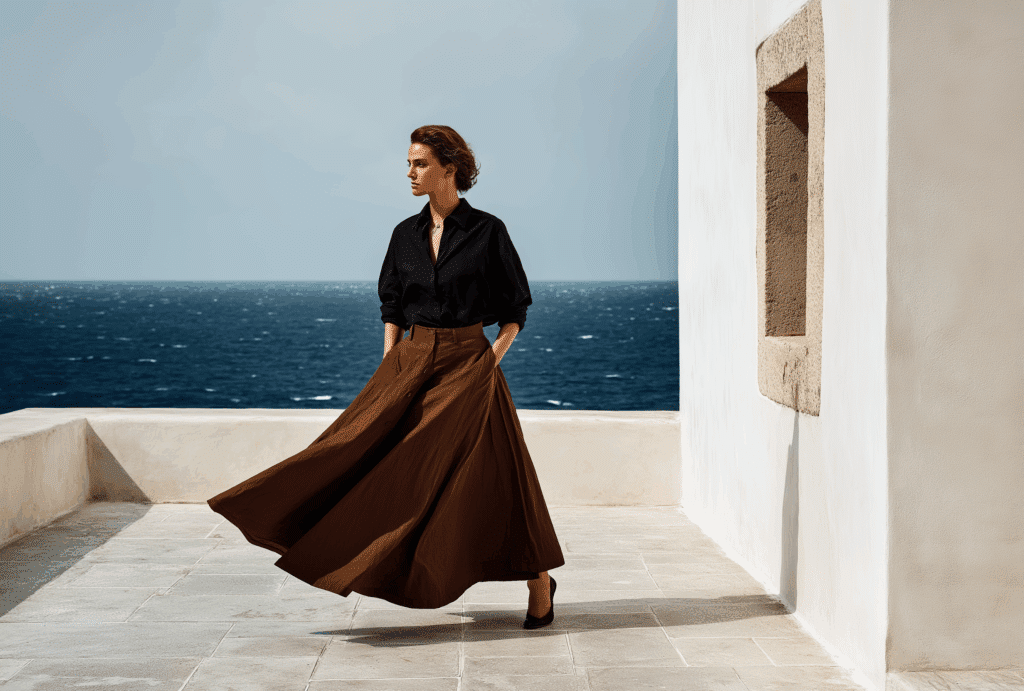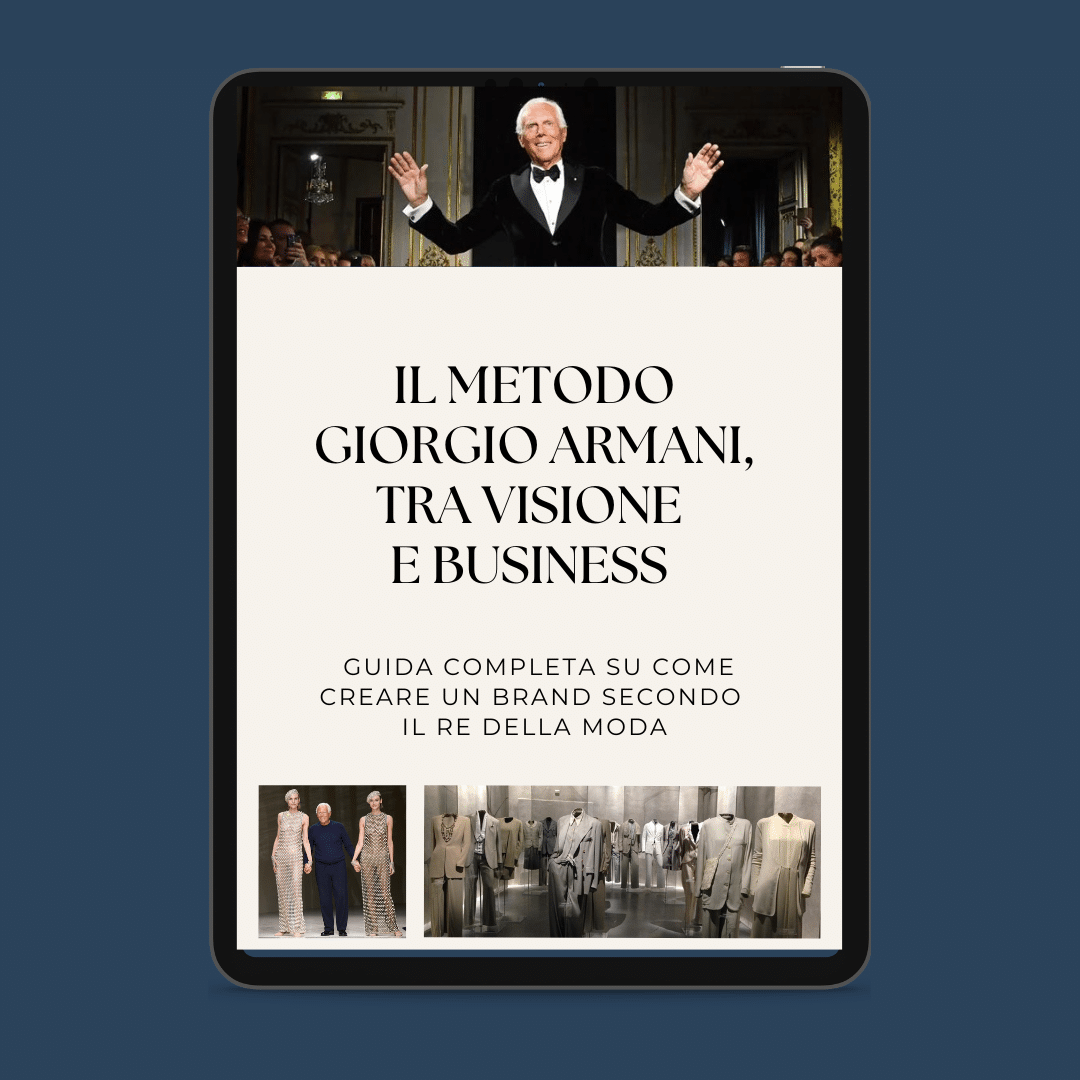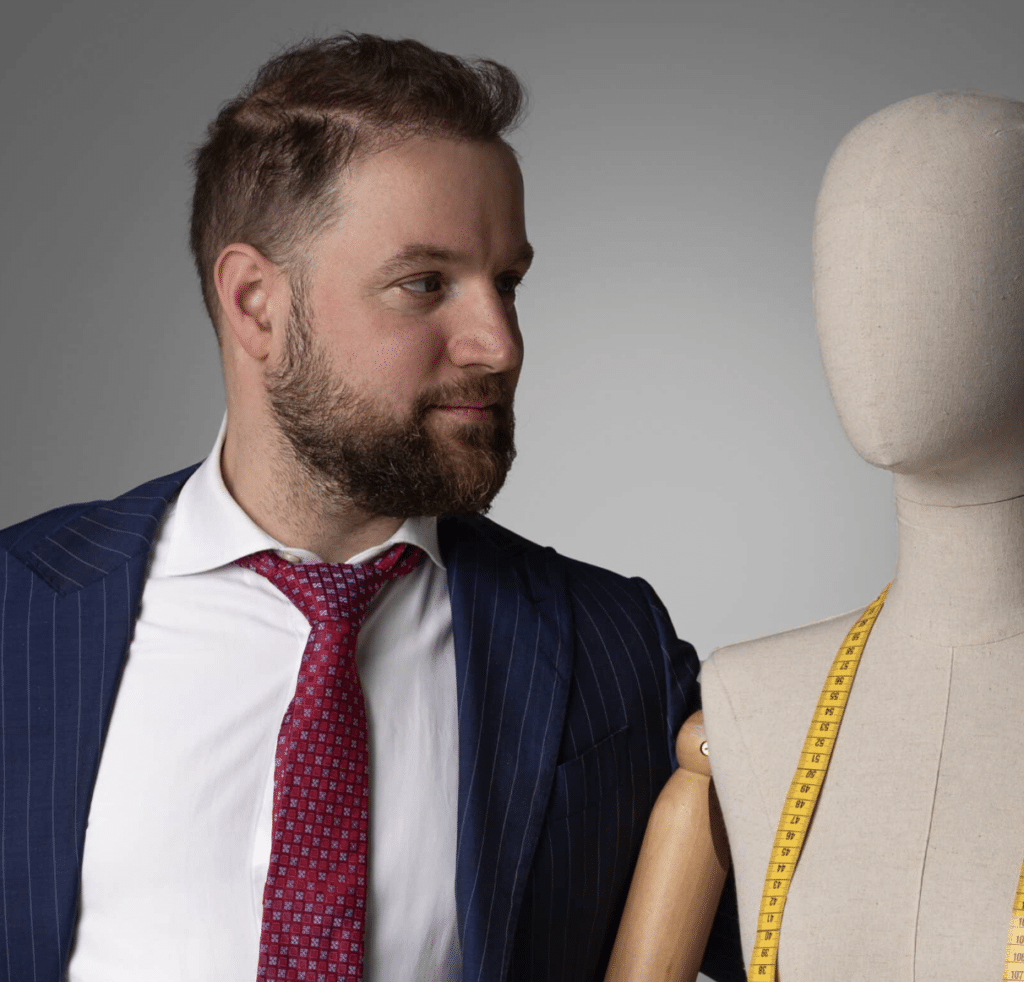The passing of King Giorgio and the legacy of the Armani brand forces us to reflect: have you always been true to yourself? In business, in creativity, in life - when everything around you seems to say that you should change, adapt, follow the trend?
Giorgio Armani I believe he was until the end of his days, representing much more than a successful designer. He embodied a new approach to fashion and everything that revolves around it, naturally blending aesthetic sensitivity, the ability to anticipate the public's tastes and entrepreneurial awareness in building a solid and enduring brand.
With his recent death at the age of 91, the fashion world - and not only - has retraced the main chapters of his extraordinary, but more often ordinary life. We all know his clothes, but perhaps the most revolutionary and innovative aspect of his long career is a lucid and pioneering vision of the fashion business.
There is a pre and an after Armani, a way of dressing that preceded his influence, and a new way of dressing that followed. The same applies to the approach to brand building.
Armani's real lesson is to have built his empire systematically doing the opposite of what advisors and market trends advisedIt chose independence when everyone was getting bought out, it maintained control when everyone was delegating, it focused on consistency instead of following the latest trend.
So let us ask ourselves: what can we learn from him today if we want to create our own brand? In this article I tell you 7 business lessons that emerge from the Armani method, with concrete examples and insights that are applicable even if you are at the beginning of your journey.
The man in the blue shirt
Giorgio Armani was among the first to give the term 'designer' a broader meaning. No longer just someone who designs clothes, but who create style, identity and coherent aesthetic universes. This vision is a role model for those who want to embark on the road to fashion and create their own brand today.

After the death of Sergio Galeotti, his partner and associate, Armani took full control of the company management, proving that a creative person can also be the strategic mind of an international organisation. It structured the group through a licensing system that is still a key component of its success today, always maintaining the stylistic consistency that makes each of its garments instantly recognisable.
In recent years, he has carefully prepared a gradual and organic management transition, relying on trusted internal figures. The group is now worth several billion euros, but the most significant legacy it leaves behind is of a different nature: the idea that making fashion is not just about making clothesbut build a strong vision, an enduring identity and a message that crosses generations.
Armani proved that it is possible to remain true to one's creative vision without sacrificing commercial successthat entrepreneurial independence can coexist with innovation, and that elegance not è just a matter of style, but a philosophy that can permeate every aspect of a company. His legacy will continue to influence not only the way people dress, but also the way fashion brands are conceived and managed on the global stage, and this is a great legacy for the designers and stylists of tomorrow!
Did you know that Armani worked at Rinascente?
Giorgio Armani is 23 years old, comes from Piacenza and finds himself behind the counter of the Rinascente in Piazza Duomo, at the very moment when Italy is about to enter the Economic boom.
Armani ends up in the menswear department almost by chance, among identical stiff jackets for the office and jumpers for the weekend. This is because in the 1950s the custom was still to go to the tailor, always wear a tie, and wear shirts with stiff collars like cardboard.
But Armani sees what others do not: a clothing system still bound by the rules imposed by a world that no longer exists.
Gaining experience in the field: lesson 1
|
But Armani studied fashion? The answer is no, and this is perhaps the first big lesson for those who dream of a career designerentrepreneurial talent can be born from direct observation of the market rather than from the classroom. How Armani started? During the years in which he moved between shop windows and department counters, Giorgio Armani learnt above all to listen to buyers, to choose, to remember tastes and preferences, and thus began to build a first particle of his creative world. |

From now on, his work ethic will always be focused on thecustomer focuswho is not an imaginary, stereotyped figure but a body that wears clothes, with its needs, fears, pleasures. And he realises something that will mark his approach to fashion forever: Those who create clothes must first of all know how to listen.
Armani begins to notice that behind every purchase there is a story, a silent need, a fear to overcome or a gesture to celebrate. This led him to think about what we now call buyers personas, representations of ideal customers, created on the basis of real data and market research.
Hence his philosophy: not fashion that imposes, but fashion that accompanies.
Clothes designed for make people feel goodto fit real bodies and improve the everyday life of the wearer.
✍️ Lesson 1 for those who want to build a brand: even before design, it studies people. Their habits, their movements, their emotions. That is where your true value is born.
Making fashion as an entrepreneur, not just a creative one
Whereas in the 1980s and 1990s, the fashion industry outsourced certain stages or production processes to external, specialised companies, Giorgio Armani did the exact opposite, proving that è possible to do fashion without school but not without total control of the process.
He maintained control over every stage: from design to production, from distribution to retail. When his competitors outsourced production to Asian suppliers and distribution to external partners, he built his own vertically integrated ecosystem.

This counter-current choice of thefashion entrepreneur par excellence stems from a deep conviction: the quality perceived by the end customer depends on the consistency of every single production step. Armani brand is not just a name on a label, it is a value system that must permeate every moment of the value chain, from the choice of fabrics to the training of shop assistants in flagship stores.
Lesson 2. How to apply it in your business:
Imagine you have an idea for a perfect dress. In most fashion companies, what happens is this: you design the dress, then you send it off to be produced in a factory in Asia (which perhaps also produces for your competitors), then you send it off to distributors who sell it in their shops alongside other brands, and finally it gets to the end customer who often doesn't even know who really created it.
Giorgio Armani he did the exact opposite. He has decided to control every single step: he designs the suit in his Milan offices, he produces it in his own factories (or those chosen by him personally), he sells it in his shops with staff trained by him, and the customer knows perfectly well that he is buying a 'real Armani'.
Financial independence is a competitive advantage
The third great lesson of theentrepreneurship in fashion according to Armani is the importance of autonomous decision-making. Giorgio Armani has systematically refused multi-billion dollar takeover offers from LVMH, Kering and other giants. When his fellow designers sold majority stakes to accelerate growth, he preferred to grow more slowly but remain the absolute master of his strategic decisions.
This choice, which many fashion and business criticised as 'conservative' or 'unvisionary', has instead proved to be the key to long-term success. What Armani teaches young designers? That freedom of decision is worth more than accelerated growth, because it allows stylistic and strategic consistency to be maintained even during market crises.
How to become a successful stylist Following the Armani brand model means building up solid cash reserves before any expansion. Only accept external financing if you retain decision-making control. Better to grow at 20% per year while remaining independent than at 50% while losing strategic autonomy. Armani established from the beginning what maximum percentage of equity he was willing to give up: 0%.
The architecture of the Armani brand, the perfect pyramid
One of the most ingenious innovations of thedesigner entrepreneur Giorgio Armani was the creation of a perfect segmentation that does not create internal cannibalisation. Giorgio Armani (€2000+ for a jacket) → Emporio Armani (€600-800) → A/X Exchange (€150-300). Each line serves different customers at different times in their lives, without price overlaps that would generate internal conflicts.
This strategy of Armani brand multi-level is the opposite of what many luxury brands do, which often launch lines at intermediate prices that end up confusing positioning and cannibalising sales of premium products. Armani, on the other hand, created net price gaps of 50-70% between tiers, with completely separate targets, channels and positioning.
The genius of this architecture emerges from the data: Emporio Armani generates 40% of the group's total revenues by serving the 25-40 age group that 'aspires' to absolute luxury. 23% of Emporio's customers then move on to Giorgio Armani within 10 years. Instead of losing these customers to Gucci or Prada, Armani 'captures' them earlier and grows them internally. A strategy of customer lifetime value ante litteram.

How to apply it in your business: Lesson 4
If you want to expand the product portfolio, create net price gaps of 50-70% between levels. Never launch a product that can be 'interchangeable' with an existing one. Each line must have separate targets, channels and positioning. Study how Apple handles iPhone SE → standard iPhone → iPhone Pro: same logic, different industry.
The most significant example of this strategy is EA7, Armani's sportswear line. When he launched it, he did not make the mistake of many luxury brands offering 'casual luxury' at intermediate prices. EA7 is deliberately positioned below Emporio (€80-150 vs €300-600) and serves a completely different need (sportswear vs business casual). Result: no cannibalisation and opening up a completely new market.
Does stylistic consistency pay off?
For fifty years, Giorgio Armani maintained an immediate recognisability that represents the true Italian styleclean lines, neutral colours, elegance without ostentation. While competitors reinvented themselves every season to feed the hype on social media, he built a visual identity so strong that an Armani suit is identifiable even without a label.
This stylistic consistency is not conservatism, but refined business strategy. L'authentic elegance of Armani stems from the understanding that luxury customers seek reassurance, not constant surprises. They want to know that by investing in an Armani garment, they are buying a piece of history that will never go out of fashion.
The greatest challenge for any Italian designer to replicate this success is to resist the temptation of constant change. When Instagram pushed all brands towards colourful and 'Instagrammable' aesthetics, Armani kept its beige-grey-navy palette. Result: while competitors who chased the trend then had to retrace their steps, Armani remained the only 'trend-proof' luxury brand.

Lesson 5: Go beyond seasonal trends. Define 3-4 distinctive elements of your brand (colours, fonts, tone of voice, values) and never deviate from them, despite market pressures. If your brand represents 'quality craftsmanship', never go low-cost even if it could generate immediate revenue. Consistency breeds trust, trust breeds premium pricing.
A 2023 survey showed that 84% of luxury consumers recognised an Armani garment without seeing the logo, compared to 31% of the industry average. This instant recognition generates pricing power that allows the brand to maintain premium prices even during market downturns. A creative leadership which translates into measurable competitive advantage.
Lesson 6: Celebrity marketing and quality testimonials
The Armani brand literally invented the celebrity marketing modern with 'American Gigolo' in 1980, when dressing Richard Gere was considered a risky move for an emerging European brand. But the self-taught designer showed extraordinary entrepreneurial intuition: he realised that a film could be worth more than a thousand traditional advertising campaigns.
Since then, the fashion and business Armani's strategy was based on long-term relationships with a few strategically chosen celebrities: Cate Blanchett (20+ years), Leonardo DiCaprio, Julia Roberts. Not 3-month commercials, but lifetime ambassadors who truly embody the brand's values. A counter-current choice in an era of micro-influencers and spot collaborations.
The ROI of this strategy is impressive: Armani's investment in celebrity dressing for the Oscars (€2-3 million annually) generates an estimated media value of €50+ million. Cate Blanchett wearing Armani to the Awards is worth more than any traditional ADV campaign, because it creates a permanent association in the consumer's mind: Armani = red carpet elegance.
The seventh lesson: adopt a long-term vision and your brand will live on
The seventh and most important lesson of thedesigner entrepreneur Giorgio Armani is about the ability to think in decades instead of quarters. In an industry obsessed with seasonal performance and immediate results, he has always reasoned with time horizons of 10-20 years. This creative leadership in the long run is perhaps the most difficult factor to replicate, but also the most decisive for sustained success.
Armani built every strategic decision thinking about how the brand would be perceived in a generation, not a season. It has invested in slow branding when everyone was pushing for fast fashion, it has prioritised quality when everyone was cutting costs, it has maintained premium prices when everyone was discounting to win markets.
When asked in 2023 why he never listed the company on the stock exchange (as many competitors did), his answer was illuminating: 'The financial markets think in quarters, I think in decades. They are not compatible'. A philosophy that has allowed him to go through six economic crises without ever losing market share or compromising brand positioning.
The Armani brand, a history and a thousand inspirations
The seven lessons of Giorgio Armani designer entrepreneur tell a counter-current story: lasting success comes from consistency, not constant adaptation. Control vs. delegation, independence vs. integration into conglomerates, quality vs. quantity, long-term celebrity vs. micro-influencer of the moment, ten-year vision vs. quarterly results.
The largest Armani inspiration for any entrepreneur is to have demonstrated that it is possible to do fashion without schoolbut not without strategy. The Italian designer turned a stylistic intuition into an 8 billion euro business empire by remaining true to principles that seemed anachronistic but turned out to be visionary.
Your brand can do the same. The important thing is to have the courage to choose a path and follow it to the end, even when everyone tells you it is impossible.
The seven lessons you have just discovered represent fifty years of entrepreneurial experimentation in the world's most competitive industry.
Armani did not theorise them at a desk: he lived them, made mistakes, corrected them and perfected them day after day. Now it is up to you to decide which of these strategies can turn your idea into a fashion brands that people will remember forever.
But how to become a successful designer applying these lessons in practice? How to turn creativity into entrepreneurship in fashion following the Armani model?
The Be a Designer method, to build your brand together
If you are dreaming of building your own fashion brand but don't know where to start, if you want to turn your passion for design into a solid and lasting business, the Be a Designer method can guide you step by step towards this goal. It is not just about learning how to design clothes, but about developing that entrepreneurial vision that has made Armani a global fashion giant.
The method integrates the best business strategies of luxury fashion with the practical tools to build a brand from scratch. Because today, in 2025, being a designer means first and foremost being a conscious entrepreneur, just as Giorgio Armani has demonstrated for fifty years.
L'authentic elegance and the creative leadership that we admired in Armani are not innate talents: they are skills that you can learn, develop and apply to your business project. The future of fashion belongs to those who know how to combine creativity and business intelligence, exactly as the master from Piacenza did.
You don't have to face this challenge alone. Just as Armani was able to surround himself with the best collaborators to build his kingdom, you too can rely on experts who know all the secrets of the fashion business.
Book a strategy consultation and discover how to turn your passion for design into the next big Italian fashion brand. 2025 could be the year your story really begins.
















